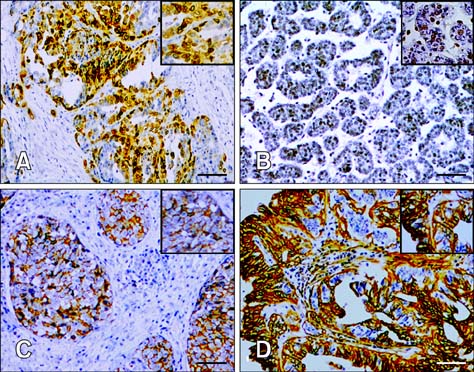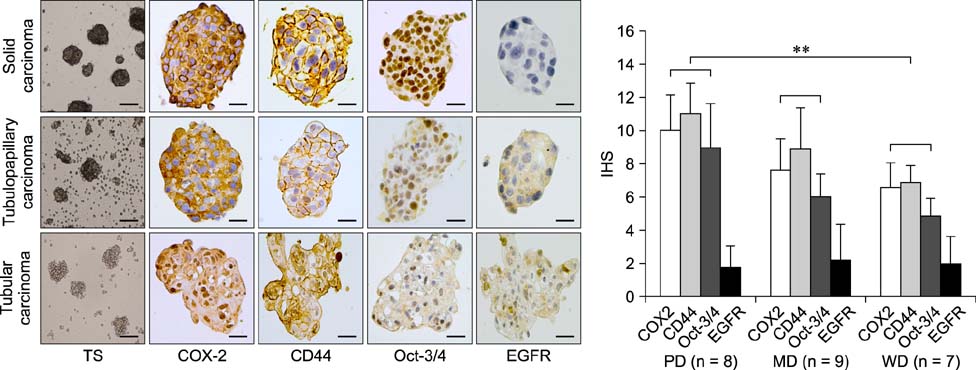J Vet Sci.
2015 Jun;16(2):225-231. 10.4142/jvs.2015.16.2.225.
The potential role of COX-2 in cancer stem cell-mediated canine mammary tumor initiation: an immunohistochemical study
- Affiliations
-
- 1Department of Veterinary Clinical Science, College of Veterinary Medicine, China Agricultural University, Beijing 100193, China. csama@sina.com
- 2Department of Veterinary Science, College of Life Science and Technology, Southwest University for Nationalities, Chengdu 610041, China.
- KMID: 2164533
- DOI: http://doi.org/10.4142/jvs.2015.16.2.225
Abstract
- Increasing evidence suggests that cancer stem cells (CSCs) are responsible for tumor initiation and maintenance. Additionally, it is becoming apparent that cyclooxygenase (COX) signaling is associated with canine mammary tumor development. The goals of the present study were to investigate COX-2 expression patterns and their effect on CSC-mediated tumor initiation in primary canine mammary tissues and tumorsphere models using immunohistochemistry. Patterns of COX-2, CD44, octamer-binding transcription factor (Oct)-3/4, and epidermal growth factor receptor (EGFR) expression were examined in malignant mammary tumor (MMT) samples and analyzed in terms of clinicopathological characteristics. COX-2 and Oct-3/4 expression was higher in MMTs compared to other histological samples with heterogeneous patterns. In MMTs, COX-2 expression correlated with tumor malignancy features. Significant associations between COX-2, CD44, and EGFR were observed in low-differentiated MMTs. Comparative analysis showed that the levels of COX-2, CD44, and Oct-3/4 expression varied significantly among TSs of three histological grades. Enhanced COX-2 staining was consistently observed in TSs. Similar levels of staining intensity were found for CD44 and Oct-3/4, but EGFR expression was weak. Our findings indicate the potential role of COX-2 in CSC-mediated tumor initiation, and suggest that COX-2 inhibition may help treat canine mammary tumors by targeting CSCs.
MeSH Terms
-
Animals
Antigens, CD44/genetics/metabolism
Biomarkers, Tumor/genetics/metabolism
Cell Transformation, Neoplastic/*genetics/metabolism
Cyclooxygenase 2/*genetics/metabolism
Dog Diseases/*genetics/metabolism
Dogs
Female
Immunohistochemistry/veterinary
Mammary Neoplasms, Animal/*genetics/metabolism
Mammary Neoplasms, Experimental/*genetics/metabolism
Neoplastic Stem Cells/*metabolism
Octamer Transcription Factor-3/genetics/metabolism
Receptor, Epidermal Growth Factor/genetics/metabolism
Retrospective Studies
Antigens, CD44
Biomarkers, Tumor
Cyclooxygenase 2
Octamer Transcription Factor-3
Receptor, Epidermal Growth Factor
Figure
Reference
-
1. Arnoletti JP, Upson J, Babb JS, Bellacosa A, Watson JC. Differential stromal and epithelial localization of cyclooxygenase-2 (COX-2) during colorectal tumorigenesis. J Exp Clin Cancer Res. 2005; 24:279–287.2. Borena BM, Bussche L, Burvenich C, Duchateau L, Van de Walle GR. Mammary stem cell research in veterinary science: an update. Stem Cells Dev. 2013; 22:1743–1751.
Article3. Clemente M, Pérez-Alenza MD, Illera JC, Peña L. Histological, immunohistological, and ultrastructural description of vasculogenic mimicry in canine mammary cancer. Vet Pathol. 2010; 47:265–274.
Article4. Cocola C, Anastasi P, Astigiano S, Piscitelli E, Pelucchi P, Vilardo L, Bertoli G, Beccaglia M, Veronesi MC, Sanzone S, Barbieri O, Reinbold RA, Luvoni GC, Zucchi I. Isolation of canine mammary cells with stem cell properties and tumour-initiating potential. Reprod Domest Anim. 2009; 44:Suppl 2. 214–217.
Article5. Doré M, Lanthier I, Sirois J. Cyclooxygenase-2 expression in canine mammary tumors. Vet Pathol. 2003; 40:207–212.
Article6. Goldschmidt M, Peña L, Rasotto R, Zappulli V. Classification and grading of canine mammary tumors. Vet Pathol. 2011; 48:117–131.
Article7. Greenhough A, Smartt HJ, Moore AE, Roberts HR, Williams AC, Paraskeva C, Kaidi A. The COX-2/PGE2 pathway: key roles in the hallmarks of cancer and adaptation to the tumour microenvironment. Carcinogenesis. 2009; 30:377–386.
Article8. Heller DA, Clifford CA, Goldschmidt MH, Holt DE, Shofer FS, Smith A, Sorenmo KU. Cyclooxygenase-2 expression is associated with histologic tumor type in canine mammary carcinoma. Vet Pathol. 2005; 42:776–780.
Article9. Hiraga T, Ito S, Nakamura H. Cancer stem-like cell marker CD44 promotes bone metastases by enhancing tumorigenicity, cell motility, and hyaluronan production. Cancer Res. 2013; 73:4112–4122.
Article10. Kumar SM, Liu S, Lu H, Zhang H, Zhang PJ, Gimotty PA, Guerra M, Guo W, Xu X. Acquired cancer stem cell phenotypes through Oct4-mediated dedifferentiation. Oncogene. 2012; 31:4898–4911.
Article11. Li HJ, Reinhardt F, Herschman HR, Weinberg RA. Cancer-stimulated mesenchymal stem cells create a carcinoma stem cell niche via prostaglandin E2 signaling. Cancer Discov. 2012; 2:840–855.
Article12. Liou JY, Ellent DP, Lee S, Goldsby J, Ko BS, Matijevic N, Huang JC, Wu KK. Cyclooxygenase-2-derived prostaglandin E2 protects mouse embryonic stem cells from apoptosis. Stem Cells. 2007; 25:1096–1103.
Article13. Magalhães GM, Terra EM, de Oliveira Vasconcelos R, de Barros Bandarra M, Moreira PRR, Rosolem MC, Alessi AC. Immunodetection of cells with a CD44+/CD24- phenotype in canine mammary neoplasms. BMC Vet Res. 2013; 9:205.
Article14. Michishita M, Akiyoshi R, Suemizu H, Nakagawa T, Sasaki N, Takemitsu H, Arai T, Takahashi K. Aldehyde dehydrogenase activity in cancer stem cells from canine mammary carcinoma cell lines. Vet J. 2012; 193:508–513.
Article15. Michishita M, Ezaki S, Ogihara K, Naya Y, Azakami D, Nakagawa T, Sasaki N, Arai T, Shida T, Takahashi K. Identification of tumor-initiating cells in a canine hepatocellular carcinoma cell line. Res Vet Sci. 2014; 96:315–322.
Article16. Moon CM, Kwon JH, Kim JS, Oh SH, Lee KJ, Park JJ, Hong SP, Cheon JH, Kim TI, Kim WH. Nonsteroidal anti-inflammatory drugs suppress cancer stem cells via inhibiting PTGS2 (cyclooxygenase 2) and NOTCH/HES1 and activating PPARG in colorectal cancer. Int J Cancer. 2014; 134:519–529.
Article17. Murphy JF, Lennon F, Steele C, Kelleher D, Fitzgerald D, Long AC. Engagement of CD44 modulates cyclooxygenase induction, VEGF generation, and proliferation in human vascular endothelial cells. FASEB J. 2005; 19:446–448.18. Neil JR, Johnson KM, Nemenoff RA, Schiemann WP. Cox-2 inactivates Smad signaling and enhances EMT stimulated by TGF-β through a PGE2-dependent mechanisms. Carcinogenesis. 2008; 29:2227–2235.
Article19. Pang LY, Argyle D. Cancer stem cells and telomerase as potential biomarkers in veterinary oncology. Vet J. 2010; 185:15–22.
Article20. Park BW, Park S, Park HS, Koo JS, Yang WI, Lee JS, Hwang H, Kim SI, Lee KS. Cyclooxygenase-2 expression in proliferative Ki-67-positive breast cancers is associated with poor outcomes. Breast Cancer Res Treat. 2012; 133:741–751.
Article21. Queiroga FL, Pires I, Lobo L, Lopes CS. The role of Cox-2 expression in the prognosis of dogs with malignant mammary tumours. Res Vet Sci. 2010; 88:441–445.
Article22. Singh B, Cook KR, Vincent L, Hall CS, Martin C, Lucci A. Role of COX-2 in tumorospheres derived from a breast cancer cell line. J Surg Res. 2011; 168:e39–e49.
Article23. Sleeckx N, de Rooster H, Veldhuis Kroeze EJB, Van Ginneken C, Van Brantegem L. Canine mammary tumours, an overview. Reprod Domest Anim. 2011; 46:1112–1131.
Article24. Stasinopoulos I, Mori N, Bhujwalla ZM. The malignant phenotype of breast cancer cells is reduced by COX-2 silencing. Neoplasia. 2008; 10:1163–1169.
Article25. Thanan R, Murata M, Ma N, Hammam O, Wishahi M, El Leithy T, Hiraku Y, Oikawa S, Kawanishi S. Nuclear localization of COX-2 in relation to the expression of stemness markers in urinary bladder cancer. Mediators Inflamm. 2012; 2012:165879.
Article26. Trosko JE. Cancer stem cells and cancer nonstem cells: from adult stem cells or from reprogramming of differentiated somatic cells. Vet Pathol. 2009; 46:176–193.
Article27. Webster JD, Yuzbasiyan-Gurkan V, Trosko JE, Chang CC, Kiupel M. Expression of the embryonic transcription factor Oct4 in canine neoplasms: a potential marker for stem cell subpopulations in neoplasia. Vet Pathol. 2007; 44:893–900.
Article28. Wilson H, Huelsmeyer M, Chun R, Young KM, Friedrichs K, Argyle DJ. Isolation and characterisation of cancer stem cells from canine osteosarcoma. Vet J. 2008; 175:69–75.
Article29. Xu K, Shu HK. EGFR activation results in enhanced cyclooxygenase-2 expression through p38 mitogen-activated protein kinase-dependent activation of the Sp1/Sp3 transcription factors in human gliomas. Cancer Res. 2007; 67:6121–6129.
Article
- Full Text Links
- Actions
-
Cited
- CITED
-
- Close
- Share
- Similar articles
-
- Expression of CD133, CD44, CK7, and OCT4 in Animal Cancers
- Tumorsphere formation and cancer stem cell characterization of REM134 canine mammary carcinoma cells
- Metastasis prognostic factors and cancer stem cell-related transcription factors associated with metastasis induction in canine metastatic mammary gland tumors
- Critical diagnostic and cancer stem cell markers in neoplastic cells from canine primary and xenografted pulmonary adenocarcinoma
- Mutations of p53 Tumor Suppressor Gene in Spontaneous Canine Mammary Tumors



